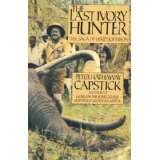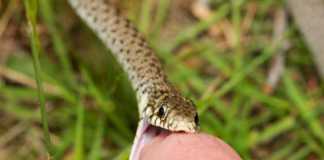A white man appeared at dawn, and Werner and Wally asked him what in hell he was doing there.
“Catching snakes. My business. And you, sir, are sitting on one of them. They’re very delicate, you know. Kindly get off that sack.”
Von Alvensleben did a maneuver that would have won him a gold medal in any Olympic competition, the Baron bailing off the hood like a demented dervish. There, in the sack on which he had been sitting and sleeping, was a Banded Water Cobra, Boulengeria annulata. Why it had not bitten him through the rough cloth is anybody’s guess. Maybe just luck.
There is no known antivenin. (A short excerpt from the fascinating biography of Walter Walker “Wally” Johnson, ‘The Last Ivory Hunter: The Saga of Wally Johnson’. You can read more about the book here.)

Wally Johnson was a professional ivory hunter during a time when elephants inflicted terror on the Mozambique countryside, destroying crops and killing villagers. Wally was one of the best and last true hunters. He spent half a century in Mozambique hunting for “White Gold”. He shot nearly 100 lions, 1300 elephants and probably 2000 buffalos. In the book, author Peter Hataway-Capstick tells the memoirs of Wally, his African bush adventures, his awe-inspiring stories and encounters with charging Elephants, Buffalos and the deadliest snakes of Africa.
One of these majestic snakes is with no doubt the Naja annulata (formerly Boulengerina annulata), better known as the Banded Water Cobra or the Ringed Water Cobra. Don’t mistaken it with the Banded Water Snake, which is a species endemic to the southern United States. The unique water cobra on the other hand, is native to western and central Africa, and together with the Congo Water Cobra, it is one of only two species of water cobras in the world. This aquatic species rarely ever wanders far away from water, and hardly ever shows itself to humans. It is regarded as one of the most secretive cobras on the planet.
Watch this amazingly rare encounter with a Ringed Water Cobra:
Really no anti-venom against Banded Water Cobras?
The Naja annulata is a fairly large and heavy snake with a short and flat head. Adults can reach maximum lengths of 9 ft (2.7 m), and the fact they spend much of their time in water can be seen on their scales, which are very smooth. The Banded Water Cobra can be found in numerous African countries, from Angola, Congo, Gabon up to Cameroon and more. There, this Water Cobra will mostly hide in bushy and wooded banks along rivers and lakes, keeping themselves constantly under the radar.
Despite their secretive way of life, the Naja annulatas are usually more active during the light of day, and most of their time is spent in the water. They are able to dive to depths of 82 ft (25 m) and stay underwater for up to 10 minutes. On land however, they move slower and will usually hide in the bushes of the river banks, in holes or underneath rocks. Like most Cobras, they will attack and bite only if they feels threatened. Their menu of prey predominantly includes fish, although they might also devour some toads or frogs from time to time. As mentioned in Wally’s biography, the venom of the Naja annulatas is not well known, and is mainly neurotoxic. According to all our sources, there is currently no specific anti-venom produced against this mysterious cobra species.
The stranger opened the bag and poured out the snake, which really put on a performance. In a second bag, he also had a black mamba, which he teased with a stick, somewhat to the discomfort of Wally and Werner. Finally, he put the snakes back in the bags, thanked the men for keeping an eye on his car, and went on what I hope was his merry way. (Another short excerpt from the biography of Walter Walker “Wally” Johnson, ‘The Last Ivory Hunter: The Saga of Wally Johnson‘. You can read more about the book here.)
- For more fast facts about Cobras click here.
- For further discussion on snakes, scientific classifications, venom research and much more, check the resources available in “The New Encyclopedia of Snakes”, available on Amazon.com.
 |
Click here to take a glimpse at
|
- If you feel like a having a real Book on Snake Bites, then get this book: ‘Snakes and Snakebite‘ by Visser, J. & Chapman D.S.
- And if you love African Hot snakes, this is THE Book for you: ‘Dangerous Snakes of Africa’ by Spawls, S. and Branch, B.


